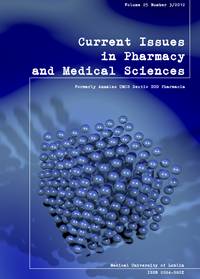Serum heparan sulfate concentration in healthy subjects
DOI:
https://doi.org/10.12923/j.2084-980X/25.3/a.02Keywords:
heparan sulfate, glycosaminoglycans, proteoglycans, ageing process, lipids profileAbstract
Heparan sulfate is one of the essential components of extracellular matrices and plasma membrane. They take part in the interaction with protein ligands, which affects the metabolism, transport, information transfer, support and regulation in all organ systems. The aim of the study was to examine the physiological HS level in the serum of the healthy subjects, as well as to check if this level is age- and sex- related.
The research was conducted on 30 healthy subjects: 16 women and 14 men, aged from 23 to 65 years, with the average of 30 years. Quantificational determination of HS was performed with the use of Heparan Sulfate ELISA kit. Concentrations of total cholesterol, HDL-cholesterol and triglycerides were measured with the use of standard enzymatic methods. The LDL-cholesterol was analyzed by direct method, and non-HDL-cholesterol was calculated. Based on the conducted research, it can be concluded that higher HS serum concentrations were observed in the group of healthy men compared to women group, and in the older ≥30 year-old group. The determination of serum HS concentration should consider gender and age differences in the result interpretation. Changes in HS serum concentrations are not correlated with the changes in the lipid profile parameters. For complete determining of existing statistical correlations between HS concentration, age, gender and the lipid profile parameters study results require confirmation on a greater number of cases.
References
1. Bishop J. R., Schuksz M., Esko J.D.: Heparan sulphate proteoglycans fine-tune mammalian in physiology. Nature, 446, 1030, 2007.
2. Feyzi E. et al.: Age-dependent modulation of heparan sulfate structure and function. J Biol. Chem., 29, 13395, 1998.
3. Fuki I.V., Iozzo R.V., Williams K.J.: Perlecan heparan sulfate proteoglycan: a novel receptor that mediates a distinct pathway for ligand catabolism. J. Biol. Chem., 275, 25742, 2000.
4. Hofmann-Kiefer K.F. et al.: Serum heparan sulfate levels are elevated in endotoxemia. Eur J Med Res, 14, 526, 2009.
5. Hooper NM.: Glypican-1 facilitates prion conversion in lipid rafts. J Neurochem. 116, 721, 2011.
6. Kolset S.O., Salmivirta M.: Cell surface heparan sulfate proteoglycans and lipoprotein metabolism. Cellular and molecular life sciences, 56, 857, 1999.
7. Labat-Robert J., A.M. Robert A.M., Robert L.: Aging of the extracellular matrix, Medicine&Longevite, 4, 27, 2012.
8. Lewis J.E., Xu X.: Abnormal Glomerular Permeability Characteristics in Diabetic Nephropathy. Diabetes Care, 31, 202, 2008.
9. Pillarisetti S.: Lipoprotein modulation of subendothelial heparan sulfate proteoglycans (perlecan) and atherogenicity. Trends in Cardiovascular Medicine, 10, 60, 2000.
10. Segev A., Nili N., Strauss B.H.: The role of perlecan in arterial injury and angiogenesis. Cardiovascular Research, 63, 603, 2004.
11. Tarbell J. M. Tarbell: Shear stress and the endothelial transport barrier, Cardiovasc Res. 87, 320, 2010.
12. Tomatsu S. et al. Heparan sulfate levels in mucopolysaccharidoses and mucolipidoses. J Inherit. Metab. Dis., 28, 743, 2005.
13. Tovar A.M.F. et al.: Age-related changes in populations of aortic glycosaminoglycans: species with low affinity for plasma low-density lipoproteins, and not species with high affinity, are preferentially affected. Arteriosclerosis, thrombosis and vascular biology, 18, 604, 1998.
14. Yousif M.M. et al.: Role of Endogenous Heparinoids and Bacterial Infection in Bleeding from Oesophageal Varices Complicating Liver Cirrhosis, Arab Journal of Gastroenterology, 9, 64, 2008.
Downloads
Published
Issue
Section
License
Copyright (c) 2012 Authors

This work is licensed under a Creative Commons Attribution-NonCommercial-NoDerivatives 3.0 Unported License.


